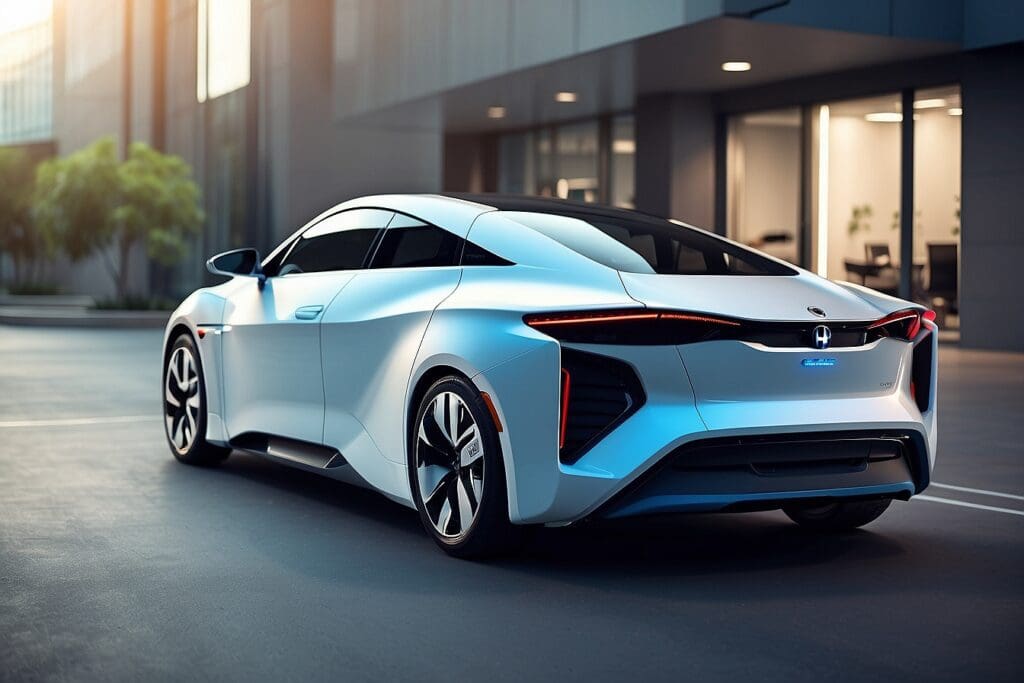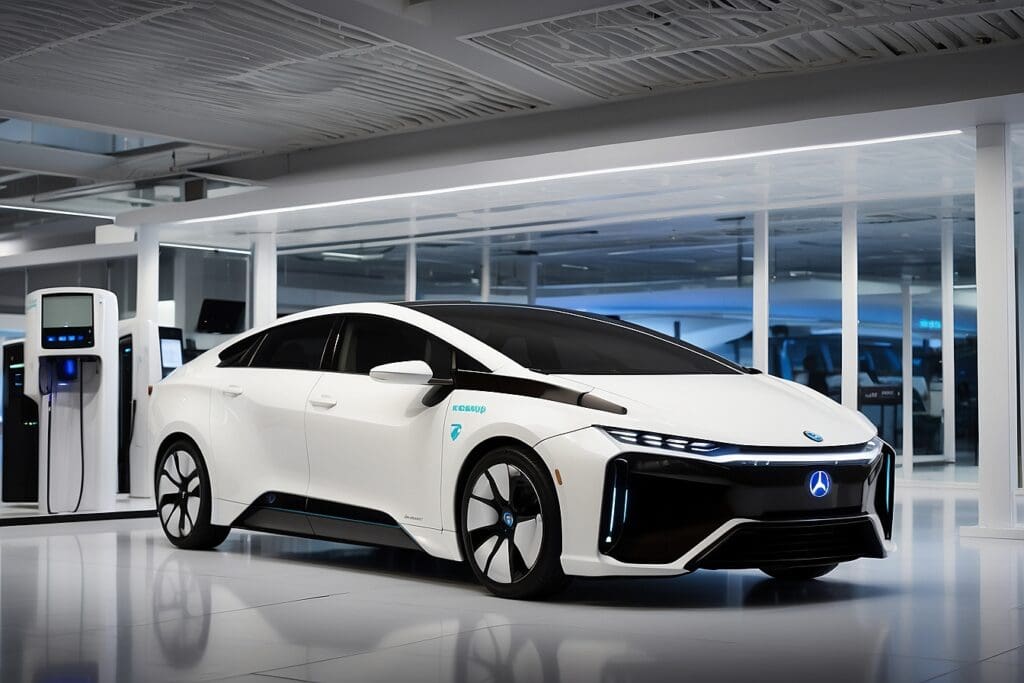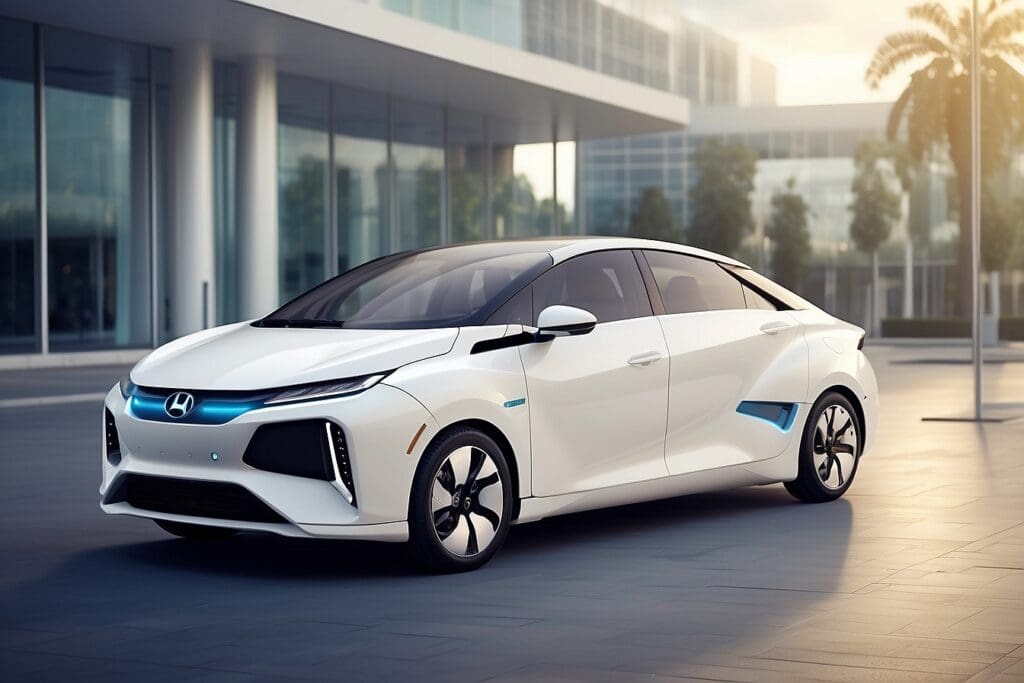We’re all too familiar with that wince-inducing moment at the petrol station, as prices seem to reach new heights with every visit. Just like yourselves, we’ve grown weary of these expensive trips and have embarked on a journey to uncover a more sustainable path – enter hydrogen fuel cells.
Our expedition will take us through the ins and outs of how these innovative cells aren’t merely powering vehicles but are steering us towards an exciting new chapter in transportation.
So, buckle up for what promises to be an electrifying exploration!
Key Takeaways
- Hydrogen fuel cells turn chemical energy from hydrogen into electricity, with water and heat as the only by-products, offering a clean alternative to fossil fuels in vehicles.
- Types of hydrogen fuel cells vary, including PEM and SOFC, each fitting different uses like transport and power generation; this diversity helps in pushing zero-emissions across industries.
- The auto industry is seeing more hydrogen-powered vehicles like buses and heavy-duty lorries due to their long range and fast refuelling capabilities; this shift could lead to significant reductions in transportation-related carbon emissions.
- Global collaborations are key for advancing hydrogen infrastructure with countries sharing knowledge to refine technology, reduce costs, and build an international network of refuelling stations for seamless integration.
- Green innovations aim to produce hydrogen using renewable energy sources such as solar or wind while overcoming economic challenges through cost-effective production methods.
Overview of Hydrogen Fuel Cells
Hydrogen fuel cells operate by converting chemical energy from hydrogen gas into electrical power, producing only water and heat as byproducts. There are several types of fuel cells, including proton exchange membrane (PEM) and solid oxide fuel cells (SOFC), each with their own unique advantages and applications.
Basic working principle
At the heart of hydrogen fuel cells lies a beautifully simple process. We take hydrogen, commonly found in water, and oxygen from the air we breathe. Inside the fuel cell, these two elements interact in an electrochemical reaction which produces electricity to power an electric motor.
There’s no combustion like in traditional engines, just clean energy and water as by-products.
This technology empowers us to drive vehicles without harmful carbon emissions. Imagine cruising down the road with nothing but pure water vapour trailing behind you – that’s what driving a fuel cell electric vehicle feels like.
It’s not only about better performance; it’s about sustainable transportation and paving the way for zero-emissions vehicles all while tackling our planet’s environmental challenges head-on.
Types of fuel cells
Transitioning from the basic working principle, let’s delve into the various types of fuel cells.
- Proton Exchange Membrane (PEM) Fuel Cells: These are commonly used in transport and stationary power applications due to their compact size and quick start-up time.
- Solid Oxide Fuel Cells (SOFC): These operate at high temperatures, making them suitable for large-scale industrial and central power generation.
- Molten Carbonate Fuel Cells (MCFC): Known for high efficiency, they are often used in combined heat and power applications.
- Direct Methanol Fuel Cells (DMFC): Utilising methanol as a fuel source, these are ideal for small portable electronic devices.
- Alkaline Fuel Cells (AFC): Historically significant for space programmes, these cells boast high efficiency and low-cost materials.
- Phosphoric Acid Fuel Cells (PAFC): Well-suited for commercial and industrial use due to their longevity, reliability, and ability to run on reformed natural gas.
- Regenerative Fuel Cells: These have the capability to switch between electrolysis mode for hydrogen generation and fuel cell mode for electricity production.
- Microbial Fuel Cells: Harnessing the power of bacteria to generate electricity by consuming organic matter, these hold promise for wastewater treatment plants and remote sensing devices.
Historical context and evolution
Transitioning from the discussion on types of fuel cells to delve into the historical context and evolution, it is important to recognise the rich heritage of hydrogen fuel cell technology.
Dating back to the 1800s, scientists like William Grove laid the groundwork for this revolutionary energy source. This early concept has evolved considerably over time, witnessing significant breakthroughs in efficiency and practical application.
As we trace its evolution through major milestones and technological advancements, including its role in powering space missions, we understand that hydrogen fuel cells have a deep-rooted history shaped by continuous innovation and progress towards sustainability.
The Impact of Hydrogen Fuel Cells on the Auto Industry

Hydrogen fuel cells have emerged as a game-changer in the transportation sector, offering zero-emission vehicles that promise to revolutionise the auto industry. With significant milestones in transportation applications and current market analysis showing promising trends, hydrogen fuel cells are set to make a lasting impact on the automotive industry.
Significance in transportation sector
Hydrogen fuel cells play a significant role in the transportation sector by offering a clean and sustainable energy source for vehicles. This technology enables zero-emission driving, addressing environmental concerns related to carbon emissions from traditional combustion engines.
With the increasing focus on green technology and renewable energy sources, hydrogen fuel cells have become a key player in reducing the carbon footprint of the automotive industry.
The development and integration of this technology across various modes of transportation, including cars, buses, trucks, and trains, are crucial steps towards achieving eco-friendly mobility solutions.
The commercialisation of hydrogen-powered vehicles in heavy-duty transport sectors is gaining momentum due to their ability to provide long-range capabilities and quick refuelling times.
Moreover, advancements in refuelling infrastructure are contributing to expanding the usage of fuel cell electric vehicles (FCEVs), facilitating their widespread adoption within the automotive market.
Milestones in transportation applications
Hydrogen fuel cells have achieved significant milestones in transportation applications, contributing to the development of zero-emissions vehicles and clean energy solutions.
- Integration into Public Transport: Hydrogen-powered buses and trains are being successfully deployed in various cities, reducing carbon emissions and providing efficient public transportation options.
- Adoption in Heavy-Duty Vehicles: The integration of hydrogen fuel cells in heavy-duty transport vehicles, such as lorries and forklifts, is gaining momentum due to their ability to provide long-range capabilities without harmful emissions.
- Expansion in Maritime Industry: Advancements in hydrogen fuel cell technology are leading to the adoption of zero-emission ships and boats, demonstrating the potential for sustainable maritime transportation.
- Applications in Aviation: Research and development efforts are underway to explore the use of hydrogen fuel cells in aircraft propulsion systems, aiming to reduce the environmental impact of air travel.
- Inclusion in Alternative Mobility Solutions: Hydrogen fuel cells are being incorporated into innovative mobility solutions, including drones and unmanned aerial vehicles, paving the way for eco-friendly aerial transportation.
Current market analysis
We are witnessing a burgeoning interest in hydrogen fuel cells within the auto industry. The shift towards these energy systems is reshaping the market, presenting new opportunities and challenges. Below, we lay out the current state of the market with a focus on key statistics and trends.
| Region | Market Share | Key Players | Government Initiatives |
|---|---|---|---|
| Asia-Pacific | Leading | Toyota, Hyundai | Subsidies for fuel cell vehicles, investments in infrastructure |
| Europe | Growing | Mercedes-Benz, Stellantis | Strict emissions regulations, funding for R&D |
| North America | Emerging | General Motors, Honda | Renewable energy targets, tax incentives |
| Rest of World | Nascent | Various startups | Varies by country, generally fewer initiatives |
This table reflects the dynamic landscape, highlighting where momentum is building. Asia-Pacific is at the forefront, steered by mature policies and strong corporate leadership. Europe’s focus on sustainability is accelerating growth, while North America is gradually entering the race. In other regions, the progress is slower, but interest is sparking. Our commitment to a greener future fuels our efforts in monitoring and contributing to these developments.
Technological Advancements and Challenges

Global patent trends show a strong focus on hydrogen fuel cell technology, with ongoing innovations and solutions in green hydrogen production to address economic and efficiency challenges.
Read more about the latest advancements in hydrogen fuel cells and the potential for disruption in the auto industry.
Global patent trends
Analysing global patent trends reveals a surge in innovation and development of hydrogen fuel cell technology for vehicle applications. Companies worldwide are actively pursuing patents for advancements in hydrogen production, storage, and the integration of fuel cells into transportation systems. The increasing number of patents signifies growing interest and investment in this eco-friendly alternative energy source, reflecting a shift towards sustainable mobility solutions.
In addition to enhancing environmental sustainability, these patent trends indicate a robust market push towards accelerating the adoption of hydrogen-powered vehicles. With continuous R&D efforts globally, we can anticipate breakthrough technologies that address challenges related to infrastructure development and fuel efficiency while advancing the potential for widespread commercialisation of hydrogen fuel cell vehicles.
Innovations and solutions in green hydrogen production
Innovations in green hydrogen production are driving advancements towards sustainable energy sources. Researchers and companies are developing cutting-edge technologies to produce hydrogen through renewable resources like solar, wind, and hydroelectric power.
These innovations aim to address the challenges of traditional hydrogen production methods, such as high energy consumption and carbon emissions. Additionally, advancements in electrolysis techniques further contribute to the eco-friendly production of hydrogen by using water as a feedstock, resulting in zero-emission output.
Moreover, solutions for efficient storage and transportation of green hydrogen are being developed to meet the increasing demand for clean fuel alternatives. Specialised infrastructure is being designed to accommodate large-scale storage and distribution networks for green H2, enabling its use in heavy-duty transport applications while significantly reducing carbon footprints associated with conventional fuels.
Economic and efficiency challenges
Hydrogen fuel cell technology presents economic and efficiency challenges that need to be addressed for widespread adoption. One of the main hurdles is the high cost of producing and storing hydrogen, which makes it less competitive against traditional fossil fuels.
Additionally, there are infrastructure investment requirements for setting up hydrogen refuelling stations, posing a challenge to its integration into existing transportation systems.
Innovations targeting cost-effective green hydrogen production and efficient storage solutions are essential to overcome these challenges.
Moreover, enhancing the overall efficiency of hydrogen fuel cells is crucial for their viability in heavy-duty transport applications. This involves improving the durability and performance of fuel cell components while ensuring minimal energy loss during electricity generation from hydrogen.
Future Outlook for Hydrogen Fuel Cells in the Auto Industry
The future outlook for hydrogen fuel cells in the auto industry is promising, with forecasts indicating a significant increase in market penetration and potential disruptive impact on the transportation sector.
Efforts for global collaboration and advancements in green hydrogen production are paving the way for a cleaner, more sustainable automotive future.
Forecasting the next decade
The future for hydrogen fuel cells in the auto industry looks promising, with advancements in technology driving significant growth. Market trends indicate a gradual shift towards zero-emission vehicles, including heavy-duty transport, as eco-friendly cars gain traction.
The next decade is expected to witness an upsurge in clean technology and energy innovation, paving the way for widespread adoption of hydrogen-powered vehicles. Collaborative efforts for global sustainability will continue to drive progress in green hydrogen production and storage, ensuring a greener and more sustainable transportation sector.
Innovations are propelling the prospect of disruptive impacts on the automotive landscape, encouraging environmentally conscious individuals to support conservation efforts through embracing these advancements.
Potential for disruptive impact
Hydrogen fuel cells have the potential to disrupt the auto industry by offering a sustainable, zero-emission alternative to traditional combustion engines. As heavy-duty transport and eco-friendly cars gain traction, hydrogen-powered vehicles are set to revolutionise the electric vehicle market.
The innovation in hydrogen fuel technology promises an environmentally friendly solution for transportation that could significantly reduce carbon emissions and reliance on fossil fuels.
With increased investment and technological advancements driving this shift, there is substantial potential for disruptive impact in creating a greener future for transportation.
Moving forward, it’s crucial for us as environmentally conscious individuals to support the development and adoption of hydrogen fuel cells in automobiles, contributing towards a cleaner, more sustainable world where zero-emissions vehicles become the standard.
Efforts for global collaboration
To advance the widespread use of hydrogen fuel cell technology, global collaboration among governments, industries, and research institutions is vital. Sharing knowledge and resources can accelerate the development of infrastructure for sustainable hydrogen production and distribution.
This includes establishing international standards for fuelling stations, storage systems, and vehicle technologies to enable seamless integration across various nations. Moreover, collaborative efforts in research and development can lead to breakthrough innovations that enhance the efficiency and affordability of hydrogen-powered vehicles.
International partnerships also play a crucial role in fostering investment in hydrogen infrastructure on a global scale. By working together, countries can pool their expertise to address challenges such as cost reduction in green hydrogen production and expanding the availability of refuelling stations worldwide.
Conclusion
Hydrogen fuel cells are set to revolutionise the auto industry, offering environmentally conscious individuals a promising solution for zero-emissions vehicles. The potential impact of hydrogen-powered vehicles on heavy-duty transport is significant, with the ability to reduce greenhouse gas emissions and reliance on fossil fuels.
As the technology continues to advance and overcome economic and efficiency challenges, there is immense potential for hydrogen fuel cells to drive the future of eco-friendly cars and sustainable transportation.
With global collaboration efforts underway, the next decade holds promise for widespread adoption and disruptive impact in the auto industry.
The era of hydrogen fuel cells marks a pivotal milestone towards achieving zero-emissions vehicles in heavy-duty transport, presenting an exciting avenue for those supporting conservation and environmental sustainability.
This emerging technology offers a glimpse into an eco-friendly future where transportation aligns with environmental preservation objectives while meeting the demand for efficient mobility solutions.
FAQs
1. What are hydrogen fuel cells and how do they change cars?
Hydrogen fuel cells power vehicles by turning hydrogen into electricity, making cars run cleaner because they only release water.
2. Can heavy-duty transport use hydrogen fuel cells?
Yes, heavy-duty transport like lorries and buses can use hydrogen fuel cells to move goods and people without creating pollution.
3. Are all vehicles with hydrogen fuel cells good for the environment?
Absolutely! Vehicles powered by hydrogen are called zero-emissions vehicles because they don’t pollute the air at all.
4. Why might someone want to drive a hydrogen-powered vehicle?
Someone might choose a hydrogen-powered vehicle because it’s eco-friendly but still drives long distances without having to stop often like some electric cars.





